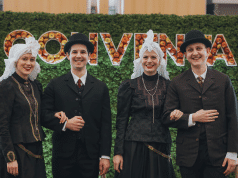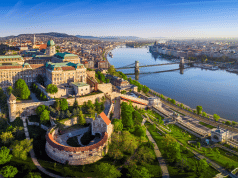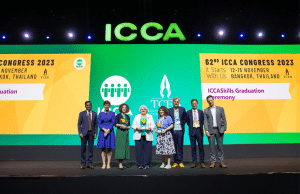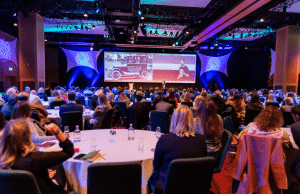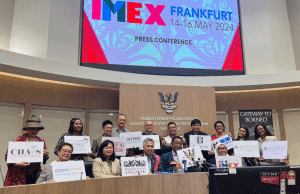Slovenia shows off various faces through its locations, meeting venues and hotels, all of which are genuinely diverse and offer clients a very wide choice.
Ljubljana
The capital, offering a blend of old charm and new cool, is a small but stylish city of arts, music, history and gastronomy. With a population of 280,000, it is conveniently compact and a true walking city. It is, therefore, logistically easy to run programmes there.
In their free time, delegates can easily explore: the Old Town quarter with its narrow cobbled streets and the Ljubljanica riverbanks that are lined with excellent restaurants (ideal for organising dine-arounds) and trendy and friendly bars. Over 60,000 university students largely contribute to the city’s youthful image and urban creativity. Ljubljana’s relaxing atmosphere and interesting shopping options – from antiques to art galleries and designer clothes – are also appreciated by its visitors, who entirely commend the city as an extremely safe city to visit and experience.
Maribor
Maribor is simultaneously charmingly small and idyllic, wedged between Pohorje’s wonderful nature on one side and wine-growing hills on the other, with the river Drava wending its way through it. The second city of Slovenia perfectly combines history, arts & culture with thermal water, ski slopes andvineyards on its outskirts.
The meeting facilities includes those provided by the Terme Maribor company, which manages several hotels, including the 5-star Habakuk with a modern congress centre and an excellent thermal & spa product. A host of incentive and outdoor teambuilding experiences are focussed on the river and the great nature in the surrounding mountains. Maribor is close to the Austrian border and the city of Graz, which is the closest airport with international connections.
Nova Gorica
Nova Gorica is situated just across the border from the Italian Gorizia and is known today as the “town of roses”. It enjoys a mild local climate and is the leading gaming and entertainment centre in the country. The HIT Group has the major hotels in the area featuring conference facilities, wellness centres and casinos. Just a short drive away, the wine routes of the Goriška Brda hills offer some of our internationally acclaimed
wines and to many are an unexpected discovery, as is the green hue of the Soča River, the queen of white-water sports in Slovenia.
Symbols:
- The Ljubljana Dragon, as can be seen on the Dragon’s Bridge, is a symbol of Ljubljana. Legend says that: “A long time ago, the Greek hero Jason and his companions from the ship Argo, stole the Golden Fleece from the Colchian king. In an effort to escape its pursuers the ship took a wrong turn and, instead of sailing south on the Aegean Sea, it found its way to the mouth of the Danube river”.
- “Stara trta”in Maribor, the oldest vine in the world, is the oldest living specimen on our planet of a noble vine that still bears grapes! With an age of over 400 years it is registered in the Guinness Book of Records as the oldest vine in the world.
Recommended by the locals:
- Ljubljanica river gives Ljubljana a special charm. Strolling along the river banks will help you feel the rhythm of the city and its inhabitants!
- Lent, the oldest part of Maribor, with its famous towers and remains of the city walls is the venue for the traditional summer Lent Festival.
- Starting from Nova Gorica, you can easily reach Goriška Brda and enjoy a visit to famous Slovenian wine producers, such as Kristančič (Movia), Ščurek.
MEETINGS IN THE ALPS
THE ALPS MIRRORED IN THE LAKES
Lake Bled, the pearl of the Julian Alps, is one of the most famous attractions in Slovenia and it is a truly magical place. An ancient castle, available for a range of events, sits high on a cliff boasting breathtaking views over the lake and surrounding mountains.
Bled can be reached in less than one hour’s drive from the capital and less than 30 minutes from the airport. Just a few kilometres away there’s another Alpine pearl, lake Bohinj, which being a mountain ribbon lake is enclosed by sheer mountains on either side. Kranjska Gora, a popular ski and all-year-round resort, boasts modern meeting facilities with a view of mountain peaks and the ski slopes.
All three resorts are located in or close to the Triglav National Park, the only national park in Slovenia, which extends along the Italian border and close to the Austrian border in the north-west of Slovenia. The park covers 880 square kilometres, or 3% of the territory of Slovenia, and was named after Slovenia’s highest mountain, Triglav (2,864m), located almost in the centre of the park.
Not only the lakes, but also the Soča river makes this part of Slovenia so incredibly special. Bovec and other places in the Soča valley are the perfect choice for pre- and post-congress tours, as well as for incentives. Another picturesque Alpine valley, the Logarska dolina, attracts visitors with its calmness and natural beauty.
Recommended by the locals:
- Cream slices (kremšnita), known as a Bled speciality for decades, has in fact now become one of the symbols of Bled!
MEETINGS ON THE COAST AND AT THE KARST
FROM ADRIATIC BLUE TO THE MYSTERIOUS KARST
Portorož is the leading coastal resort that boasts a mild climate, lush vegetation and more than 100 years of tradition in the hospitality industry, which is reflected in its high-quality hotel infrastructure. This includes several 5- and 4-star properties with excellent meeting facilities. The Lifeclass Hotels & Spa are famous for their fantastic thermal and wellness products, as well as for the congress centre. This resort currently boasts the most luxurious hotel in Slovenia, the Kempinski Palace Portorož.
Many attractions are close at hand, even within walking distance, such as the charming and historic town of Piran, once a fishing port. The Sečovlje saltpans where salt is still harvested manually, as it was centuries ago, is a landscape park and a haven for both birds and ornithologists. Incentives themed on salt-picking can be organised there for smaller groups. Many other options are also easily accessible – from boat trips with fish picnics to yachting regattas, or even a day trip to Venice by catamaran. Istria, with its vineyards, olive groves and truffles, is just around the corner.
The Slovenian Karst (also known as limestone), featuring the majority of the 9,000 caves in the country, is regarded by many as one of the most beautiful underground worlds on the planet. The Skocjan Caves, that could have been a fantastic film setting for the Lord of the Rings, are on the UNESCO World Heritage List. This region is also home to the famous Lipizzaner horses. Nearby the Lipica Stud Farm offers hotel seminar facilities and a golf course.
Symbols:
- Human fish (Proteus) is the most famous of around 130 different species of animals living in Postojna Caves,
- Piran salt from the Sečovlje Salina Nature Park is still produced today in the traditional manner.
Recommended by the locals:
- The Karst is known for its »osmice«, where farmers open their doors and serve their homegrown food and wine for one week every year. If you aren’t lucky enough to catch the right week, a tailor-made visit to the typical Karst farm-houses with tasting of the local specialities, such as Teran (indigenous Slovenian wine) and pršut (Karst prosciutto) can easily be organised.

The salt is produced by locals, who produce salt by the tradicional manner.
MEETINGS AT THE THERMAL SPAS
TAKE A DIP AND RELAX IN THE SPAS
Slovenia is also a truly smart choice for those seeking spa and welness programmes, because it has a rich tradition and incredible range of centres to choose from. Modern spa facilities are combined with the meeting rooms ,which makes a perfect combination for small and middle size conferences.
Slovenia’s spas offer extraordinary natural assets in a green environment; most are set in rural areas. There are 15 natural health resorts to choose from and they are all of a high standard. Several of them can provide very functional meeting facilities combined with relaxing and invigorating wellness programmes. To name just a few, Terme Čatež, Terme Rogaška, Terme Olimia, Terme Krka and Terme Ptuj are established players on the market. New meeting facilities in Thermana Laško were opened in 2010.
Many of the spas are found in the north- to south-eastern part of the country, often in wine-producing regions, and wine tasting is a natural extension to the sense of well being!
As remnants of the rich historic past, several ancient castles, now serving as special event venues purposes, are dotted around and complimented by modern golf courses. This is just a taster of genuine local experiences that you should try for yourselves as to be able to say… I FEEL SLOVENIA!
Symbols:
- Thermal springs with healing qualities and mineral waters that have been appreciated for centuries! Radenska is one of the best mineral waters bearing the trademark of the three hearts. Its healing properties were discovered back in the 19th century.
Advantages of Slovenian regions
- Meetings in cities
- Meetings in the alps
- Meetings on the coast and the Karst
- Meetings at the thermal spas
With many cities like Ljubljana and Maribor, the cities offer great historical and a blend of new in one. There are many charming paths and houses located through the city.
Lake Bled, lake Bohinj, Triglav and the Triglav natural park are the true pearl in the heart of the Slovenian side of the Alps. A dessert named “kremšnita” (cream slices) has become the symbol of Bled, because of its unique flavour and texture.
Portorož, Piran and the Slovenian Karst have a mediterrian feel as well as the culture, which gives the city a certain vibe.
The spas in Slovenia are very diverse, you can choose fo+rom the ones in the nature ones that are a shot away from the busy streets of local cities. Here is also many natural thermal springs, which were discovered in the 19th century. So, the Slovenian spas are a great way to rest and enjoy the beauty of Slovenia.



